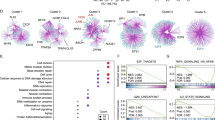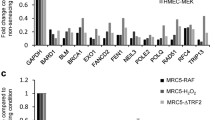Abstract
Previous studies have demonstrated that deletion of cryptochrome (Cry) genes protects p53−/− mutant mice from the early onset of cancer and extends their median life-span by about 1.5-fold. Subsequent in vitro studies had revealed that deletion of Crys enhances apoptosis in response to UV damage through activation of p73 and inactivation of GSK3β. However, it was not known at the transcriptome-wide level how deletion of Crys delays the onset of cancer in p53−/− mutant mice. In this study, the RNA-seq approach was taken to uncover the differentially expressed genes (DEGs) and pathways following UV-induced DNA damage in p53−/− and p53−/−Cry1−/−Cry2−/− mouse skin fibroblasts. Gene set enrichment analysis with the DEGs demonstrated enrichment in immune surveillance-associated genes regulated by IFN-γ and genes involved in TNFα signaling via NF-κB. Furthermore, protein network analysis enabled identification of DEGs p21, Sirt1, and Jun as key players, along with their interacting partners. It was also observed that the DEGs contained a high ratio of non-coding transcripts. Collectively, the present study suggests new genes in NF-κB regulation and IFN-γ response, as well as non-coding RNAs, may contribute to delaying the onset of cancer in p53−/−Cry1−/−Cry2−/− mice and increasing the life-span of these animals compared to p53−/− mice.






Similar content being viewed by others
References
Antoch MP, Gorbacheva VY, Vykhovanets O, Toshkov IA, Kondratov RV, Kondratova AA, Lee C, Nikitin AY (2008) Disruption of the circadian clock due to the clock mutation has discrete effects on aging and carcinogenesis. Cell Cycle 7:1197–1204. https://doi.org/10.4161/cc.7.9.5886
Attardi LD, Donehower LA (2005) Probing p53 biological functions through the use of genetically engineered mouse models. Mutat Res Mol Mech Mutagen 576:4–21. https://doi.org/10.1007/s000180050269
Attardi LD, Jacks T (1999) The role of p53 in tumour suppression: lessons from mouse models. Cell Mol Life Sci 55:48–63
Bergmann JH, Li J, Eckersley-Maslin MA, Rigo F, Freier SM, Spector DL (2015) Regulation of the ESC transcriptome by nuclear long noncoding RNAs. Genome Res 25:1336–1346. https://doi.org/10.1101/gr.189027.114
Bindea G, Mlecnik B, Hackl H, Charoentong P, Tosolini M, Kirilovsky A, Fridman WH, Pagès F, Trajanoski Z, Galon J (2009) ClueGO: a Cytoscape plug-in to decipher functionally grouped gene ontology and pathway annotation networks. Bioinformatics 25:1091–1093. https://doi.org/10.1093/bioinformatics/btp101
Bolger AM, Lohse M, Usadel B (2014) Trimmomatic: a flexible trimmer for Illumina sequence data. Bioinformatics 30:2114–2120. https://doi.org/10.1093/bioinformatics/btu170
Cavga AD, Karahan N, Keskin O, Gursoy A (2015) Taming oncogenic signaling at protein interfaces: challenges and opportunities. Curr Top Med Chem 15:1–25. https://doi.org/10.2174/1568026615666150519101956
Coornaert B, Carpentier I, Beyaert R (2009) A20: central gatekeeper in inflammation and immunity. J Biol Chem 284:8217–8221. https://doi.org/10.1074/jbc.R800032200
Dobin A, Davis CA, Schlesinger F, Drenkow J, Zaleski C, Jha S, Batut P, Chaisson M, Gingeras TR (2013) STAR: ultrafast universal RNA-seq aligner. Bioinformatics 29:15–21. https://doi.org/10.1093/bioinformatics/bts635
Donehower LA, Harvey M, Slagle BL, McArthur MJ, Montgomery CA, Butel JS, Bradley A (1992) Mice deficient for p53 are developmentally normal but susceptible to spontaneous tumours. Nature 356:215–221. https://doi.org/10.1038/356215a0
Engin HB, Keskin O, Nussinov R, Gursoy A (2012) A strategy based on protein-protein interface motifs may help in identifying drug off-targets. J Chem Inf Model 52:2273–2286. https://doi.org/10.1021/ci300072q
Filipski E, King VM, Li X et al (2002) Host circadian clock as a control point in tumor progression. J Natl Cancer Inst 94:690–697. https://doi.org/10.1093/jnci/94.9.690
Fontemaggi G, Kela I, Amariglio N, Rechavi G, Krishnamurthy J, Strano S, Sacchi A, Givol D, Blandino G (2002) Identification of direct p73 target genes combining DNA microarray and chromatin immunoprecipitation analyses. J Biol Chem 277:43359–43368. https://doi.org/10.1074/jbc.M205573200
Freeman LC (1977) A set of measures of centrality based on betweenness. Sociometry 40:35–41
Fu L, Pelicano H, Liu J, Huang P, Lee CC (2002) The circadian gene Period2 plays an important role in tumor suppression and DNA damage response in vivo. Cell 111:41–50. https://doi.org/10.1016/S0092-8674(02)00961-3
Gauger MA, Sancar A (2005) Cryptochrome, circadian cycle, cell cycle checkpoints, and cancer. Cancer Res 65:6828–6834. https://doi.org/10.1158/0008-5472.CAN-05-1119
Gekakis N, Staknis D, Nguyen HB, Davis FC, Wilsbacher LD, King DP, Takahashi JS, Weitz CJ (1998) Role of the CLOCK protein in the mammalian circadian mechanism. Science 280(80):1564–1569 %U http://www.sciencemag.org/content/280. https://doi.org/10.1126/science.280.5369.1564
Harms K, Nozell S, Chen X (2004) The common and distinct target genes of the p53 family transcription factors. Cell Mol Life Sci 61:822–842. https://doi.org/10.1007/s00018-003-3304-4
Hashiramoto A, Yamane T, Tsumiyama K, Yoshida K, Komai K, Yamada H, Yamazaki F, Doi M, Okamura H, Shiozawa S (2010) Mammalian clock gene cryptochrome regulates arthritis via proinflammatory cytokine TNF−. J Immunol 184:1560–1565. https://doi.org/10.4049/jimmunol.0903284
Hofmann JW, Zhao X, De Cecco M et al (2015) Reduced expression of MYC increases longevity and enhances health span. Cell 160:477–488. https://doi.org/10.1016/j.cell.2014.12.016
Jensen LJ, Kuhn M, Stark M, Chaffron S, Creevey C, Muller J, Doerks T, Julien P, Roth A, Simonovic M, Bork P, von Mering C (2009) STRING 8—a global view on proteins and their functional interactions in 630 organisms. Nucleic Acids Res 37:D412–D416. https://doi.org/10.1093/nar/gkn760
Jensen LJ, Kuhn M, Stark M, et al (2018) 487 items (mouse) - STRING interaction network. https://version-10-5.string-db.org/cgi/network.pl?networkId=CeX9QRlTi9g5. Accessed 19 Oct 2018
Jin MD, Zhi YW, Dao CS et al (2007) SIRT1 interacts with p73 and suppresses p73-dependent transcriptional activity. J Cell Physiol 210:161–166. https://doi.org/10.1002/jcp.20831
Kavakli IH, Baris I, Tardu M, Gül Ş, Öner H, Çal S, Bulut S, Yarparvar D, Berkel Ç, Ustaoğlu P, Aydın C (2017) The photolyase/cryptochrome family of proteins as DNA repair enzymes and transcriptional repressors. Photochem Photobiol 93:93–103. https://doi.org/10.1111/php.12669
Korkmaz T, Aygenli F, Emisoglu H, Ozcelik G, Canturk A, Yilmaz S, Ozturk N (2018) Opposite carcinogenic effects of circadian clock gene BMAL1. Sci Rep 8:16023. https://doi.org/10.1038/s41598-018-34433-4
Kume K, Zylka MJ, Sriram S, Shearman LP, Weaver DR, Jin X, Maywood ES, Hastings MH, Reppert SM (1999) mCRY1 and mCRY2 are essential components of the negative limb of the circadian clock feedback loop. Cell 98:193–205. https://doi.org/10.1016/S0092-8674(00)81014-4
Lee EG, Boone DL, Chai S et al (2000) Failure to regulate TNF-induced NF-κB and cell death responses in A20-deficient mice. Science 289(80):2350 LP–2352354
Lee JH, Gaddameedhi S, Ozturk N, Ye R, Sancar A (2013) DNA damage-specific control of cell death by cryptochrome in p53-mutant ras-transformed cells. Cancer Res 73:785–791. https://doi.org/10.1158/0008-5472.CAN-12-1994
Lee JH, Sancar A (2011a) Circadian clock disruption improves the efficacy of chemotherapy through p73-mediated apoptosis. Proc Natl Acad Sci 108:10668–10672. https://doi.org/10.1073/pnas.1106284108
Lee JH, Sancar A (2011b) Regulation of apoptosis by the circadian clock through NF-kB signaling. Proc Natl Acad Sci 108:12036–12041. https://doi.org/10.1073/pnas.1108125108/-/DCSupplemental.www.pnas.org/cgi/doi/10.1073/pnas.1108125108
Li X, Brock GN, Rouchka EC, Cooper NGF, Wu D, O’Toole TE, Gill RS, Eteleeb AM, O’Brien L, Rai SN (2017) A comparison of per sample global scaling and per gene normalization methods for differential expression analysis of RNA-seq data. PLoS One 12:e0176185. https://doi.org/10.1371/journal.pone.0176185
Lin YL, Sengupta S, Gurdziel K, Bell GW, Jacks T, Flores ER (2009) p63 and p73 transcriptionally regulate genes involved in DNA repair. PLoS Genet 5:1–13. https://doi.org/10.1371/journal.pgen.1000680
Livak KJ, Schmittgen TD (2001) Analysis of relative gene expression data using real-time quantitative PCR and the 2−ΔΔCT method. Methods 25:402–408. https://doi.org/10.1006/meth.2001.1262
Luo J, Nikolaev AY, ichiro IS et al (2001) Negative control of p53 by Sir2α promotes cell survival under stress. Cell 107:137–148. https://doi.org/10.1016/S0092-8674(01)00524-4
Ma A, Malynn B a (2012) A20: linking a complex regulator of ubiquitylation to immunity and human disease. Nat Rev Immunol 12:774–785. https://doi.org/10.1038/nri3313
Oishi K, Fukui H, Ishida N (2000) Rhythmic expression of BMAL1 mRNA is altered in clock mutant mice: differential regulation in the suprachiasmatic nucleus and peripheral tissues. Biochem Biophys Res Commun 268:164–171. https://doi.org/10.1006/bbrc.1999.2054
Ozturk N, Lee JH, Gaddameedhi S, Sancar A (2009) Loss of cryptochrome reduces cancer risk in p53 mutant mice. Proc Natl Acad Sci U S A 106:2841–2846. https://doi.org/10.1073/pnas.0813028106
Panda S, Hogenesch JB, Kay SA (2002) Circadian rhythms from flies to human. Nature 417:329–335. https://doi.org/10.1038/417329a
Rapaport F, Khanin R, Liang Y, Pirun M, Krek A, Zumbo P, Mason CE, Socci ND, Betel D (2013) Comprehensive evaluation of differential gene expression analysis methods for RNA-seq data. Genome Biol 14. https://doi.org/10.1186/gb-2013-14-9-r95
Rowlatt C, Chesterman FC, Sheriff MU (1976) Lifespan, age changes and tumour incidence in an ageing C57BL mouse colony. Lab Anim 10:419–442. https://doi.org/10.1258/002367776780956917
Sarayloo E, Tardu M, Unlu YS, Simsek S, Cevahir G, Erkey C, Kavakli IH (2017) Understanding lipid metabolism in high-lipid-producing Chlorella vulgaris mutants at the genome-wide level. Algal Res 28:244–252. https://doi.org/10.1016/j.algal.2017.11.009
Scardoni G, Laudanna C (2012) Centralities Based Analysis of Complex Networks. New Front graph thory:323–348. https://doi.org/10.5772/35846
Schoenborn JR, Wilson CB (2007) Regulation of interferon-γ during innate and adaptive immune responses. In: Advances in Immunology. Academic Press, Cambridge, pp 41–101. https://doi.org/10.1016/S0065-2776(07)96002-2
Shannon P, Markiel A, Ozier O, Baliga NS, Wang JT, Ramage D, Amin N, Schwikowski B, Ideker T (2003) Cytoscape: a software environment for integrated models of biomolecular interaction networks. Genome Res 13:2498–2504. https://doi.org/10.1101/gr.1239303
Shearman LP (2000) Interacting molecular loops in the mammalian circadian clock. Science 288(80):1013–1019. https://doi.org/10.1126/science.288.5468.1013
Smith CL, Blake JA, Kadin JA, Richardson JE, Bult CJ, the Mouse Genome Database Group (2018) Mouse genome database (MGD)-2018: knowledgebase for the laboratory mouse. Nucleic Acids Res 46:D836–D842. https://doi.org/10.1093/nar/gkx1006
Sollberger G, Strittmatter GE, Garstkiewicz M, Sand J, Beer HD (2014) Caspase-1: the inflammasome and beyond. Innate Immun 20:115–125. https://doi.org/10.1177/1753425913484374
Subramanian A, Tamayo P, Mootha VK, Mukherjee S, Ebert BL, Gillette MA, Paulovich A, Pomeroy SL, Golub TR, Lander ES, Mesirov JP (2005) Gene set enrichment analysis: a knowledge-based approach for interpreting genome-wide expression profiles. Proc Natl Acad Sci 102:15545–15550. https://doi.org/10.1073/pnas.0506580102
Takahashi JS, Hong H-K, Ko CH, McDearmon EL (2008) The genetics of mammalian circadian order and disorder: implications for physiology and disease. Nat Rev Genet 9:764–775. https://doi.org/10.1038/nrg2430
Tardu M, Bulut S, Kavakli IH (2017) MerR and ChrR mediate blue light induced photo-oxidative stress response at the transcriptional level in Vibrio cholerae. Sci Rep 7:40817. https://doi.org/10.1038/srep40817
Tardu M, Dikbas UM, Baris I, Kavakli IH (2016) RNA-seq analysis of the transcriptional response to blue and red light in the extremophilic red alga, Cyanidioschyzon merolae. Funct Integr Genomics 16:657–669. https://doi.org/10.1007/s10142-016-0521-0
Trapnell C, Roberts A, Goff L, Pertea G, Kim D, Kelley DR, Pimentel H, Salzberg SL, Rinn JL, Pachter L (2012) Differential gene and transcript expression analysis of RNA-seq experiments with TopHat and Cufflinks. Nat Protoc 7:562–578. https://doi.org/10.1038/nprot.2012.016
Tuncbag N, Kar G, Gursoy A, Keskin O, Nussinov R (2009) Towards inferring time dimensionality in protein-protein interaction networks by integrating structures: the p53 example. Mol BioSyst 5:1770–1778. https://doi.org/10.1039/B905661K
van Kempen LCL, Coussens LM (2016) MMP9 potentiates pulmonary metastasis formation. Cancer Cell 2:251–252. https://doi.org/10.1016/S1535-6108(02)00157-5
Vitaterna MH, Selby CP, Todo T, Niwa H, Thompson C, Fruechte EM, Hitomi K, Thresher RJ, Ishikawa T, Miyazaki J, Takahashi JS, Sancar A (1999) Differential regulation of mammalian Period genes and circadian rhythmicity by cryptochromes 1 and 2. Proc Natl Acad Sci 96:12114–12119. https://doi.org/10.1073/pnas.96.21.12114
Wade Harper J, Adami GR, Wei N et al (1993) The p21 Cdk-interacting protein Cip1 is a potent inhibitor of G1 cyclin-dependent kinases. Cell 75:805–816. https://doi.org/10.1016/0092-8674(93)90499-G
Wajant H, Pfizenmaier K, Scheurich P (2003) Tumor necrosis factor signaling. Cell Death Differ 10:45–65
Wisdom R, Johnson RS, Moore C (1999) c-Jun regulates cell cycle progression and apoptosis by distinct mechanisms. EMBO J 18:188–197. https://doi.org/10.1093/emboj/18.1.188
Yu H, Kim PM, Sprecher E, Trifonov V, Gerstein M (2007) The importance of bottlenecks in protein networks: correlation with gene essentiality and expression dynamics. PLoS Comput Biol 3:e59. https://doi.org/10.1371/journal.pcbi.0030059
Acknowledgment
A.G. and O.K. acknowledges the Science Academy, Turkey.
Funding
This work was supported by grants from the Istanbul Development Agency grant ISTKA-TR/14/EVK/003 (to I.H.K.). This work was also partially supported by the Turkish Scientific and Technical Research Council (TUBITAK) grant 114S446 (to N.O.).
Author information
Authors and Affiliations
Corresponding authors
Additional information
Publisher’s note
Springer Nature remains neutral with regard to jurisdictional claims in published maps and institutional affiliations.
Electronic Supplementary Material
ESM 1
(DOCX 2825 kb)
Supplementary Table 1
(XLSX 9 kb)
Supplementary Table 2
(XLSX 294 kb)
Supplementary Table 3
(XLSX 15 kb)
Supplementary Table 4
(XLSX 18.9 kb)
Rights and permissions
About this article
Cite this article
Cavga, A.D., Tardu, M., Korkmaz, T. et al. Cryptochrome deletion in p53 mutant mice enhances apoptotic and anti-tumorigenic responses to UV damage at the transcriptome level. Funct Integr Genomics 19, 729–742 (2019). https://doi.org/10.1007/s10142-019-00680-5
Received:
Revised:
Accepted:
Published:
Issue Date:
DOI: https://doi.org/10.1007/s10142-019-00680-5




